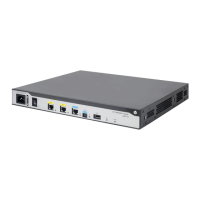99
Configuring dynamic domain name resolution
To use dynamic domain name resolution, configure DNS servers so that DNS queries can be sent to
a correct server for resolution. A DNS server manually configured takes precedence over the one
dynamically obtained through DHCP, and a DNS server configured earlier takes precedence. A
name query is first sent to the DNS server that has the highest priority. If no reply is received, it is
sent to the DNS server that has the second highest priority, and so on.
In addition, you can configure a DNS suffix that the system automatically adds to the provided
domain name for resolution. A DNS suffix manually configured takes precedence over the one
dynamically obtained through DHCP, and a DNS suffix configured earlier takes precedence. The
DNS resolver first uses the suffix that has the highest priority. If the name resolution fails, the DNS
resolver uses the suffix that has the second highest priority, and so on.
Configuration guidelines
Follow these guidelines when you configure dynamic domain name resolution:
• You can specify DNS server IPv4 addresses as follows:
{ Specify DNS server IPv4 addresses for the public network and up to 1024 VPNs.
{ Specify a maximum of six DNS server IPv4 addresses for the public network or each VPN.
• You can specify DNS server IPv6 addresses as follows:
{ Specify DNS server IPv6 addresses for the public network and up to 1024 VPNs.
{ Specify a maximum of six DNS server IPv6 addresses for the public network or each VPN.
An IPv4 name query is first sent to the DNS server IPv4 addresses. If no reply is received, it is
sent to the DNS server IPv6 addresses.
• You can specify DNS suffixes as follows:
{ Specify DNS suffixes for the public network and up to 1024 VPNs.
{ Specify a maximum of 16 DNS suffixes for the public network or each VPN.
Configuration procedure
To configure dynamic domain name resolution:
Step Command Remarks
1. Enter system view.
system-view
N/A
2. Specify a DNS server.
• Specify a DNS server IPv4 address:
dns server ip-address [ vpn-instance
vpn-instance-name ]
• Specify a DNS server IPv6 address:
ipv6 dns server ipv6-address
[ interface-type interface-number ]
[ vpn-instance vpn-instance-name ]
By default, no DNS server is
specified.
You can specify both the
IPv4 and IPv6 addresses.
3. (Optional.) Configure a
DNS suffix.
dns domain
domain-name [
vpn-instance
vpn-instance-name ]
By default, no DNS suffix is
configured and only the
provided domain name is
resolved.
Configuring the IPv6 DNS client
Configuring static domain name resolution
Static domain name resolution allows applications such as Telnet to contact hosts by using host
names instead of IPv6 addresses.

